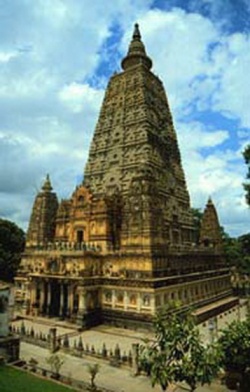Difference between revisions of "Buddhagaya"
(Created page with "thumb|250px| <poem> Buddhagaya [仏陀伽耶] (Skt, Pali; Jpn Buddagaya) The place where Shakyamuni attained enlightenment under the bodhi tree....") |
|||
| (12 intermediate revisions by 3 users not shown) | |||
| Line 1: | Line 1: | ||
[[File:Mahabodi.jpg|thumb|250px|]] | [[File:Mahabodi.jpg|thumb|250px|]] | ||
<poem> | <poem> | ||
| − | |||
| − | |||
| − | The place where Shakyamuni attained | + | |
| + | |||
| + | |||
| + | [[Buddhagaya]] | ||
| + | |||
| + | |||
| + | [[仏陀伽耶]] (Skt, [[Pali]]; Jpn [[Buddagaya]]) [[Bodhgaya]]: The [[bodhimanda]] of the [[Buddha’s]] [[enlightenment]] located in North-eastern [[India]] in the [[state]] of [[Bihar]]. | ||
| + | |||
| + | One of the four [[pilgrimage]] sites mentioned in the [[Mahaparinibbana Sutta]]. | ||
| + | |||
| + | [[Bodhgaya]] - Location of [[Vajrasana]], the place under the [[bodhi tree]] where the [[Buddha]] [[attained]] [[enlightenment]] | ||
| + | |||
| + | |||
| + | The place where [[Shakyamuni]] [[attained]] [[Enlightenment]] under the [[Bodhi tree]]. Today it is called [[Bodh Gaya]] or [[Buddh Gaya]]. Located about ten kilometers {{Wiki|south}} of [[Gaya]] in the [[state]] of {{Wiki|Bihar}}, northeastern [[India]], [[Bodh Gaya]] is one of the four [[sacred]] sites connected with [[Shakyamuni]]; the other three | ||
| + | |||
| + | are [[Lumbini]], his birthplace; [[Deer Park]], where he gave his first {{Wiki|sermon}}; and [[Kushinagara]], near the site of his [[Death]], or entry into [[Nirvana]]. [[Bodh Gaya]] is located {{Wiki|west}} of the Lilaja [[River]], or the | ||
| + | |||
| + | [[Nairanjana River]], in which [[Shakyamuni]] immersed himself after having renounced [[Ascetic]] practices. In [[Bodh Gaya]] stands a massive pyramid-shaped [[Buddhist]] monument known as the [[Mahabodhi Temple]], which measures about fifty meters high. Its origins are assigned to a simple [[shrine]] built by {{Wiki|King}} [[Ashoka]] to mark the location of [[Bodhi tree]]. It was rebuilt and enlarged in the sixth century C.E. | ||
| + | |||
| + | |||
</poem> | </poem> | ||
{{R}} | {{R}} | ||
[http://www.sgilibrary.org/search_dict.php?SearchSelect=dict&p=2&m=1&in=2&q=Enlightenment www.sgilibrary.org] | [http://www.sgilibrary.org/search_dict.php?SearchSelect=dict&p=2&m=1&in=2&q=Enlightenment www.sgilibrary.org] | ||
[[Category:Buddhist Terms]] | [[Category:Buddhist Terms]] | ||
| − | + | ||
| − | [[Category: | + | [[Category:Bodh Gaya]] |
Latest revision as of 19:59, 27 January 2024
Buddhagaya
仏陀伽耶 (Skt, Pali; Jpn Buddagaya) Bodhgaya: The bodhimanda of the Buddha’s enlightenment located in North-eastern India in the state of Bihar.
One of the four pilgrimage sites mentioned in the Mahaparinibbana Sutta.
Bodhgaya - Location of Vajrasana, the place under the bodhi tree where the Buddha attained enlightenment
The place where Shakyamuni attained Enlightenment under the Bodhi tree. Today it is called Bodh Gaya or Buddh Gaya. Located about ten kilometers south of Gaya in the state of Bihar, northeastern India, Bodh Gaya is one of the four sacred sites connected with Shakyamuni; the other three
are Lumbini, his birthplace; Deer Park, where he gave his first sermon; and Kushinagara, near the site of his Death, or entry into Nirvana. Bodh Gaya is located west of the Lilaja River, or the
Nairanjana River, in which Shakyamuni immersed himself after having renounced Ascetic practices. In Bodh Gaya stands a massive pyramid-shaped Buddhist monument known as the Mahabodhi Temple, which measures about fifty meters high. Its origins are assigned to a simple shrine built by King Ashoka to mark the location of Bodhi tree. It was rebuilt and enlarged in the sixth century C.E.
